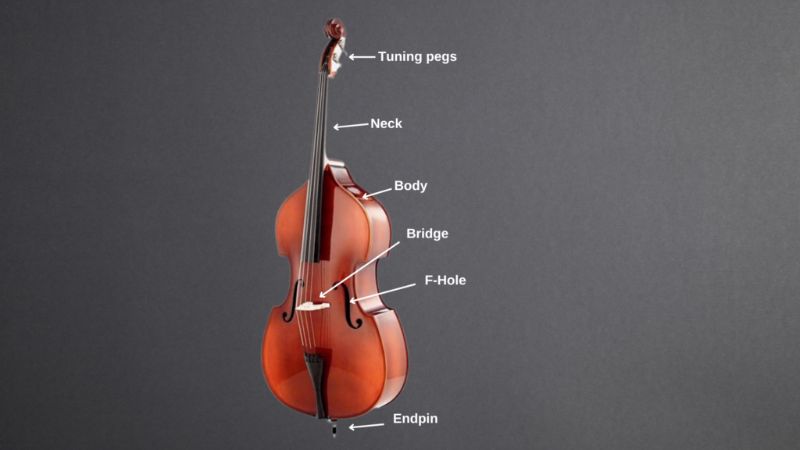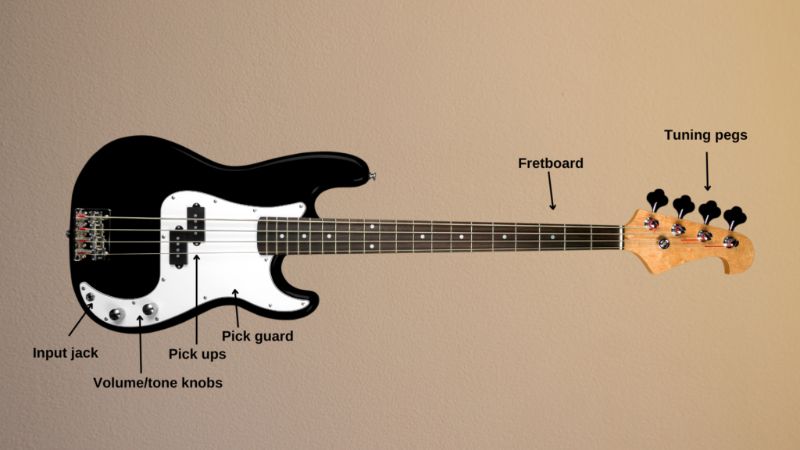If you are a bass guitarist, you may be surprised to pick up a double bass and find that the strings are tuned exactly the same. Bass guitar and double bass may not look anything alike besides the fact that they both have 4 strings. However, both instruments are low in pitch and are generally used as rhythmic support instruments. But, while they are typically tuned the same, they are entirely different instruments in look, playing style, and functionality.
This article will break down the differences and similarities between bass guitar and double bass.
Differences between bass guitar and double bass
Both bass guitar and double bass are important instruments that are necessary for both modern and classical music. Here are the main differences between bass guitar and double bass.
Size and shape
The most obvious difference between a bass guitar and double bass is the size and shape. They look completely different!
Double basses resemble a large cello. They have a large curved body with 2 “f-holes”, a raised wooden bridge, a metal endpin at the bottom of the instrument, a relatively short fretless neck and fingerboard, and a headstock with tuning pegs pointed behind the instrument. They are around 6 feet tall and weigh around 20-25 pounds.

On the other hand, bass guitars are much smaller and look very similar to an electric guitar with only four strings. The parts of a bass guitar include a long neck with a fretted fingerboard, a body with a pickguard, pickups, volume/tone controls, and an input jack. They are usually around 34 inches long and weigh about 9 pounds.

Playing style
Another major difference between bass guitar and double bass is the playing style.
Double bass is played upright while standing or sitting on a stool. Players either fingerpick or use a bow coated in resin. The sound resonates acoustically through the large body and the “f-holes”. The neck of a double bass also does not have frets, making it much more difficult to play notes since you can easily play out of tune by placing your fingers wrong. Double basses are primarily used in classical music and jazz but are also seen in country, bluegrass, and even occasionally in rock music.
Playing with a bow allows double bassists to sustain notes for much longer than it is possible to by plucking notes.
Bass guitar is played just like the electric guitar. The strap is slung over the bassist’s shoulder and played by fingerpicking, slapping, or using a pick. Instead of the sound being produced acoustically, the pickups located under the strings on a bass guitar transfer the sound to the amp through an unbalanced quarter-inch cable. Bass guitars have frets that allow bassists to play the correct pitch easily. Bass guitars are versatile instruments used for rock, heavy metal, funk, progressive, pop, and more!
String type
While both bass guitar and double bass are tuned the same and have the same number of strings, they use a different type of string that creates a different tone.
Double basses use flat-wound strings designed specifically for upright basses. A flat wound string simply means that the steel winding is flush and has no rounded bumps. The steel winding is generally around a nylon or steel core. Flatwound strings produce a warm tone that can sound muddy on bass guitars, but they sound great on double basses because of the acoustics.
Bass guitars can also use flat-wound strings but usually have round-wound, half-round, or tape-wound strings. These strings offer brighter, punchier sounds that fit better with modern styles of music.
Difficulty level
While neither instrument is easy to learn, the double bass is a much more difficult instrument to learn than the bass guitar. This comes down to the fact that double bass is very large, has no frets, and often requires a bow to play. This is not to say that bass guitar is an easy instrument to learn. It is just less complicated than double bass.
Different purposes
Bass guitar was designed for the main purpose of playing rock music. So, a bass guitar doubles the octave of a guitar and is generally a support instrument in a rock band. Double bass, on the other hand, was created as the lowest instrument for string ensembles and symphonies.
Bass guitars require amps
Bass guitars don’t play very loud at all on their own, so they are heavily reliant on bass amps to make sound. Acoustic bass guitars do exist, but they aren’t used much as most bass guitarist play with a full band and need a bass amp to project their sound. Double basses have a massive acoustic body that naturally projects sound. Even in large symphony settings double basses are rarely miked.
Similarities between bass guitar and double bass
While bass guitar and double bass are very different, they still have a few key similarities:
They are both generally tuned the same.
Bass guitar and double bass are almost always tuned the same, in perfect 4ths starting at E1-A1-D2-G2. However, some bassists of both instruments may opt to use alternative tunings.
They both have four strings.
Standard bass guitars and double basses always have 4 strings. However, some bass guitars have 5 or 6 strings to allow for an extended playable range. It is VERY rare to find double basses with more than 4 strings, but it is still possible. More commonly, double basses will have a low-C extension reaching above the scroll. Bassists with a low-C extension can quickly adjust the lowest string to be either a D1 or a C1.
They are both used to cover the low-end notes in a song.
While double basses and electric bass guitars are used for different styles of music and different purposes, they both are used as the low frequency backbone instruments of there respective fields. In an orchestra, double bass is the lowest instrument, and in a rock band, bass guitar covers the low end frequencies.
History of double bass
Double bass is the largest and lowest pitch stringed instrument commonly used in symphony orchestras, jazz, bluegrass, country, and rockabilly music. Early examples of the double bass date back as far as the 16th century. However, these instruments were tuned in various ways and had between 2-5 strings. The modern double bass with 4 strings tuned to E-A-D-G came around in the early 20th century. Double basses are generally around 6 feet tall and weigh 20 to 25 pounds. Before the invention of the electric bass guitar, double bass was the primary instrument used to carry the low notes of a song.
History of bass guitar
Bass guitars are a relatively new instrument. The first bass guitar was created in the 1930s but wasn’t marketed widely until the 1950s by Fender. In comparison, classical guitars (which aren’t very different from modern steel string or electric guitars) have been around for hundreds of years.
Bass guitar was invented as a way to transform the upright bass into a more accessible instrument that could be transported easily and play louder. Throughout the 1950s and 60s, bass guitar gained popularity, and musicians switched from using double bass to electric bass guitars. Bassists such as Paul Mccartney, Monk Montgomery, and Carol Kaye were among the first to use bass guitars in live shows and records.
Can bass guitarists play double bass?
There is a massive learning curve to double bass, and even a seasoned bass guitarist would have difficulty playing double bass. You’ll have to learn how to hold the instrument and learn completely new techniques. The most challenging part of the switch would probably be that double basses are fretless, so you’ll have to build muscle memory to finger the right notes.
Can double bassists play bass guitar?
Double bassists have a head start on playing bass guitar. The electric bass was originally invented as a portable version of the double bass that could easily be amplified, so the instrument wouldn’t take much time for double bassists to learn.
Wrapping up
Double bass and bass guitar are very similar instruments. While they may not look alike, they serve similar musical functions and are tuned to the same notes. However, despite the two bass instruments’ similarities, they require different playing styles.
Feel free to reach out if you want to learn more about bass and guitar, or have any other musical questions. I am always happy to help!





